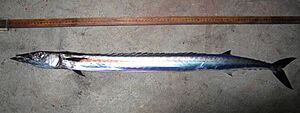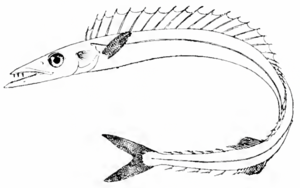Snake mackerel facts for kids
Quick facts for kids Snake mackerel |
|
|---|---|
 |
|
 |
|
| Conservation status | |
| Scientific classification | |
| Genus: |
Gempylus
|
| Species: |
serpens
|
| Synonyms | |
|
|
The snake mackerel (Gempylus serpens) is a fascinating fish. It is the only species in its group, called the Gempylus genus. This fish belongs to the Gempylidae family, which is also known as "snake mackerels."
You can find snake mackerels all over the world. They live in warm tropical and subtropical oceans. Sometimes, adult snake mackerels swim into cooler, temperate waters. They can be found as deep as 600 meters (about 2,000 feet) underwater. Scientists have noticed that snake mackerels from the Atlantic Ocean and the Indo-Pacific Ocean have slightly different numbers of bones in their spine. This might mean they are actually different species!
Contents
What Does the Snake Mackerel Look Like?
The snake mackerel has a very long, thin body. It is also flat from side to side. Its head is long and pointed, and it has a large mouth. The lower jaw sticks out further than the upper jaw. Both jaws are full of sharp teeth. The first few teeth in the upper jaw are even bigger, like fangs!
This fish has small pelvic fins located under its larger pectoral fins. It has two dorsal fins on its back. The first dorsal fin is long and spiny. Right after it is the second dorsal fin, which has softer rays. The anal fin is on its belly, opposite the second dorsal fin. Both the dorsal and anal fins are followed by 6 or 7 smaller finlets.
The snake mackerel has two lateral lines, which help it sense movement in the water. Most of its scales are missing. Its body is a shiny brown color, and its fins are dark. This fish can grow to be about 1 meter (3.3 feet) long.
How the Snake Mackerel Lives
Adult snake mackerels move up and down in the water each day. This is called a diel vertical migration. During the day, they stay in deeper water. At night, they swim closer to the surface to find food. Young snake mackerels do the opposite! They stay near the surface during the day and go deeper at night.
Snake mackerels eat many different things. They hunt squid, small ocean crustaceans, and other bony fishes. Some of their favorite meals include lanternfishes, flying fishes, sauries, and mackerel. Larger fish like tuna and marlin sometimes eat snake mackerels. Once, an 80 cm (31 inch) long snake mackerel was found inside a dead black swallower fish, which was only 25 cm (10 inches) long!
Reproduction and Life Cycle
Female snake mackerels lay a lot of eggs, from 300,000 to 1,000,000 at a time. They can spawn (lay eggs) all year long. We know that they lay eggs in places like the Caribbean Sea and off the coast of Florida. Male snake mackerels are ready to reproduce when they are about 43 cm (17 inches) long. Females are ready when they are about 50 cm (20 inches) long. As these fish grow older and move into deeper, darker water, their eyes change. They lose the cells that help them see color and gain more cells that help them see in dim light.
Snake Mackerels and People
People sometimes catch snake mackerels by accident. This happens when they are fishing for tuna using longlines. Snake mackerels are not a very important fish for commercial fishing. They are sometimes sold frozen or used to make sausages and fish cakes.
In Hawaii, this fish is called hāuliuli. People there think it tastes good, whether it's cooked or dried. It is said that King Kamehameha, a famous Hawaiian king, didn't really like it. He once said it was "a delicious fish for the back country people," meaning it was fine for those who couldn't get better fish.
A famous explorer named Thor Heyerdahl wrote about seeing snake mackerels. This happened during his Kon-Tiki expedition when he was sailing on a raft in the open ocean at night. One night, a mysterious fish landed on a crew member's sleeping bag. They caught it and described it as "over three feet long, as slender as a snake, with dull black eyes and long snout with a greedy jaw full of long sharp teeth. The teeth were sharp as knives and could be folded back into the roof of the mouth to make way for what is swallowed." Heyerdahl later noted that scientists thought this fish lived deep in the ocean. But his experience showed that at night, Gempylus (the snake mackerel) comes up high, even above the surface of the sea!



